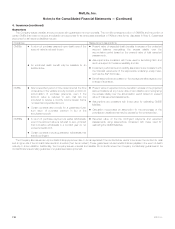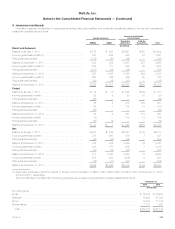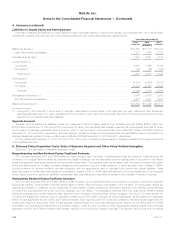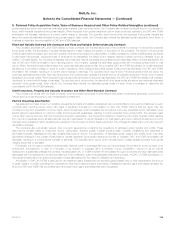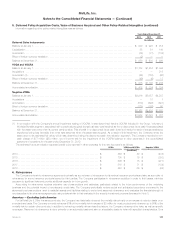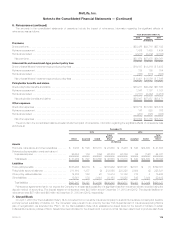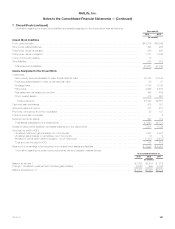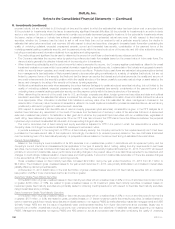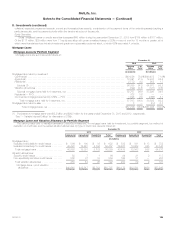MetLife 2013 Annual Report Download - page 123
Download and view the complete annual report
Please find page 123 of the 2013 MetLife annual report below. You can navigate through the pages in the report by either clicking on the pages listed below, or by using the keyword search tool below to find specific information within the annual report.MetLife, Inc.
Notes to the Consolidated Financial Statements — (Continued)
5. Deferred Policy Acquisition Costs, Value of Business Acquired and Other Policy-Related Intangibles (continued)
gross margins are below the previously estimated gross margins. Each reporting period, the Company also updates the actual amount of business in-
force, which impacts expected future gross margins. When expected future gross margins are below those previously estimated, the DAC and VOBA
amortization will increase, resulting in a current period charge to earnings. The opposite result occurs when the expected future gross margins are
above the previously estimated expected future gross margins. Each period, the Company also reviews the estimated gross margins for each block of
business to determine the recoverability of DAC and VOBA balances.
Fixed and Variable Universal Life Contracts and Fixed and Variable Deferred Annuity Contracts
The Company amortizes DAC and VOBA related to these contracts over the estimated lives of the contracts in proportion to actual and expected
future gross profits. The amortization includes interest based on rates in effect at inception or acquisition of the contracts. The amount of future gross
profits is dependent principally upon returns in excess of the amounts credited to policyholders, mortality, persistency, interest crediting rates, expenses
to administer the business, creditworthiness of reinsurance counterparties, the effect of any hedges used and certain economic variables, such as
inflation. Of these factors, the Company anticipates that investment returns, expenses and persistency are reasonably likely to impact significantly the
rate of DAC and VOBA amortization. Each reporting period, the Company updates the estimated gross profits with the actual gross profits for that
period. When the actual gross profits change from previously estimated gross profits, the cumulative DAC and VOBA amortization is re-estimated and
adjusted by a cumulative charge or credit to current operations. When actual gross profits exceed those previously estimated, the DAC and VOBA
amortization will increase, resulting in a current period charge to earnings. The opposite result occurs when the actual gross profits are below the
previously estimated gross profits. Each reporting period, the Company also updates the actual amount of business remaining in-force, which impacts
expected future gross profits. When expected future gross profits are below those previously estimated, the DAC and VOBA amortization will increase,
resulting in a current period charge to earnings. The opposite result occurs when the expected future gross profits are above the previously estimated
expected future gross profits. Each period, the Company also reviews the estimated gross profits for each block of business to determine the
recoverability of DAC and VOBA balances.
Credit Insurance, Property and Casualty Insurance and Other Short-Duration Contracts
The Company amortizes DAC for these contracts, which is primarily composed of commissions and certain underwriting expenses, in proportion to
historic and future earned premium over the applicable contract term.
Factors Impacting Amortization
Separate account rates of return on variable universal life contracts and variable deferred annuity contracts affect in-force account balances on such
contracts each reporting period, which can result in significant fluctuations in amortization of DAC and VOBA. Returns that are higher than the
Company’s long-term expectation produce higher account balances, which increases the Company’s future fee expectations and decreases future
benefit payment expectations on minimum death and living benefit guarantees, resulting in higher expected future gross profits. The opposite result
occurs when returns are lower than the Company’s long-term expectation. The Company’s practice to determine the impact of gross profits resulting
from returns on separate accounts assumes that long-term appreciation in equity markets is not changed by short-term market fluctuations, but is only
changed when sustained interim deviations are expected. The Company monitors these events and only changes the assumption when its long-term
expectation changes.
The Company also periodically reviews other long-term assumptions underlying the projections of estimated gross margins and profits. These
assumptions primarily relate to investment returns, policyholder dividend scales, interest crediting rates, mortality, persistency and expensesto
administer business. Management annually updates assumptions used in the calculation of estimated gross margins and profits which may have
significantly changed. If the update of assumptions causes expected future gross margins and profits to increase, DAC and VOBA amortization will
decrease, resulting in a current period increase to earnings. The opposite result occurs when the assumption update causes expected future gross
margins and profits to decrease.
Periodically, the Company modifies product benefits, features, rights or coverages that occur by the exchange of a contract for a new contract, or by
amendment, endorsement, or rider to a contract, or by election or coverage within a contract. If such modification, referred to as an internal
replacement, substantially changes the contract, the associated DAC or VOBA is written off immediately through income and any new deferrable costs
associated with the replacement contract are deferred. If the modification does not substantially change the contract, the DAC or VOBA amortization on
the original contract will continue and any acquisition costs associated with the related modification are expensed.
Amortization of DAC and VOBA is attributed to net investment gains (losses) and net derivative gains (losses), and to other expenses for the amount
of gross margins or profits originating from transactions other than investment gains and losses. Unrealized investment gains and losses represent the
amount of DAC and VOBA that would have been amortized if such gains and losses had been recognized.
MetLife, Inc. 115







